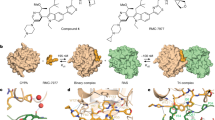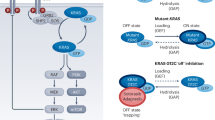Abstract
The KRAS oncogene product is considered a major target in anticancer drug discovery1,2,3. However, direct interference with KRAS signalling has not yet led to clinically useful drugs3,4,5,6,7,8. Correct localization and signalling by farnesylated KRAS is regulated by the prenyl-binding protein PDEδ, which sustains the spatial organization of KRAS by facilitating its diffusion in the cytoplasm9,10,11. Here we report that interfering with binding of mammalian PDEδ to KRAS by means of small molecules provides a novel opportunity to suppress oncogenic RAS signalling by altering its localization to endomembranes. Biochemical screening and subsequent structure-based hit optimization yielded inhibitors of the KRAS–PDEδ interaction that selectively bind to the prenyl-binding pocket of PDEδ with nanomolar affinity, inhibit oncogenic RAS signalling and suppress in vitro and in vivo proliferation of human pancreatic ductal adenocarcinoma cells that are dependent on oncogenic KRAS. Our findings may inspire novel drug discovery efforts aimed at the development of drugs targeting oncogenic RAS.
This is a preview of subscription content, access via your institution
Access options
Subscribe to this journal
Receive 51 print issues and online access
$199.00 per year
only $3.90 per issue
Buy this article
- Purchase on Springer Link
- Instant access to full article PDF
Prices may be subject to local taxes which are calculated during checkout




Similar content being viewed by others
References
Malumbres, M. & Barbacid, M. RAS oncogenes: the first 30 years. Nature Rev. Cancer 3, 459–465 (2003)
Gelb, M. H. et al. Therapeutic intervention based on protein prenylation and associated modifications. Nature Chem. Biol. 2, 518–528 (2006)
Downward, J. Targeting RAS signalling pathways in cancer therapy. Nature Rev. Cancer 3, 11–22 (2003)
Berndt, N., Hamilton, A. D. & Sebti, S. M. Targeting protein prenylation for cancer therapy. Nature Rev. Cancer 11, 775–791 (2011)
Roberts, P. J. & Der, C. J. Targeting the Raf-MEK-ERK mitogen-activated protein kinase cascade for the treatment of cancer. Oncogene 26, 3291–3310 (2007)
Maurer, T. et al. Small-molecule ligands bind to a distinct pocket in Ras and inhibit SOS-mediated nucleotide exchange activity. Proc. Natl Acad. Sci. USA 109, 5299–5304 (2012)
Patgiri, A., Yadav, K. K., Arora, P. S. & Bar-Sagi, D. An orthosteric inhibitor of the Ras-Sos interaction. Nature Chem. Biol. 7, 585–587 (2011)
Sun, Q. et al. Discovery of small molecules that bind to K-Ras and inhibit Sos-mediated activation. Angew. Chem. Int. Edn 51, 6140–6143 (2012)
Chandra, A. et al. The GDI-like solubilizing factor PDEδ sustains the spatial organization and signalling of Ras family proteins. Nature Cell Biol. 14, 329–329 (2012)
Ismail, S. A. et al. Arl2-GTP and Arl3-GTP regulate a GDI-like transport system for farnesylated cargo. Nature Chem. Biol. 7, 942–949 (2011)
Zhang, H. et al. Photoreceptor cGMP phosphodiesterase δ subunit (PDEδ) functions as a prenyl-binding protein. J. Biol. Chem. 279, 407–413 (2004)
Chen, Y. X. et al. Synthesis of the Rheb and K-Ras4B GTPases. Angew. Chem. Int. Edn 49, 6090–6095 (2010)
Chidley, C., Haruki, H., Pedersen, M. G., Muller, E. & Johnsson, K. A yeast-based screen reveals that sulfasalazine inhibits tetrahydrobiopterin biosynthesis. Nature Chem. Biol. 7, 375–383 (2011)
Vedadi, M. et al. Chemical screening methods to identify ligands that promote protein stability, protein crystallization, and structure determination. Proc. Natl Acad. Sci. USA 103, 15835–15840 (2006)
Monovich, L. G. et al. Discovery of potent, selective, and orally active carboxylic acid based inhibitors of matrix metalloproteinase-13. J. Med. Chem. 52, 3523–3538 (2009)
Wright, K. J. et al. An ARL3–UNC119–RP2 GTPase cycle targets myristoylated NPHP3 to the primary cilium. Genes Dev. 25, 2347–2360 (2011)
Zhang, H. et al. UNC119 is required for G protein trafficking in sensory neurons. Nature Neurosci. 14, 874–880 (2011)
Elad-Sfadia, G., Haklai, R., Balan, E. & Kloog, Y. Galectin-3 augments K-Ras activation and triggers a Ras signal that attenuates ERK but not phosphoinositide 3-kinase activity. J. Biol. Chem. 279, 34922–34930 (2004)
Paz, A., Haklai, R., Elad-Sfadia, G., Ballan, E. & Kloog, Y. Galectin-1 binds oncogenic H-Ras to mediate Ras membrane anchorage and cell transformation. Oncogene 20, 7486–7493 (2001)
Bhagatji, P., Leventis, R., Rich, R., Lin, C. J. & Silvius, J. R. Multiple cellular proteins modulate the dynamics of K-ras association with the plasma membrane. Biophys. J. 99, 3327–3335 (2010)
Wouters, F. S., Verveer, P. J. & Bastiaens, P. I. H. Imaging biochemistry inside cells. Trends Cell Biol. 11, 203–211 (2001)
Grecco, H. E. et al. In situ analysis of tyrosine phosphorylation networks by FLIM on cell arrays. Nature Methods 7, 467–472 (2010)
Grecco, H. E., Roda-Navarro, P. & Verveer, P. J. Global analysis of time correlated single photon counting FRET-FLIM data. Opt. Express 17, 6493–6508 (2009)
Moore, P. S. et al. Genetic profile of 22 pancreatic carcinoma cell lines. Virchows Arch. 439, 798–802 (2001)
Berrozpe, G., Schaeffer, J., Peinado, M. A., Real, F. X. & Perucho, M. Comparative-analysis of mutations in the p53 and K-ras genes in pancreatic-cancer. Int. J. Cancer 58, 185–191 (1994)
Perez-Tomas, R. Multidrug resistance: retrospect and prospects in anti-cancer drug treatment. Curr. Med. Chem. 13, 1859–1876 (2006)
Acknowledgements
The research leading to these results has received funding from the European Research Council under the European Union’s Seventh Framework Program (FP7/2007-2013)/ERC Grant agreement no. 268309 to H.W., and no. 268782 to A.W. The Compound Management und Screening Center (COMAS), Dortmund, Germany, is acknowledged for carrying out high-throughput screening and data analysis. G.Z. acknowledges the Fonds der Chemischen Industrie for a Kekulé Scholarship. We thank K. Michel for help with western blot analysis. We are grateful to C. Degenhart, A. Wolf, S. Baumann and A. Choidas for help with screening assay development and for the determination of solubility, membrane permeability and stability of deltarasin.
Author information
Authors and Affiliations
Contributions
A.W., P.I.H.B. and H.W. conceived the project. H.W., G.T. and G.Z. developed the screen and chemistry to generate the PDEδ inhibitor, P.I.H.B. designed the cell biological experiments and A.W. with S.I. solved the structures by X-ray crystallography. A.W., H.W., S.I. and G.Z. designed the PDEδ structure-based inhibitor development. S.A.H. developed the inducible shRNA systems and the xenograft model, G.Z. synthesized the inhibitors and performed the biochemical and biophysical characterization experiments, B.P. performed the real-time cell analysis, FACS and western blot analysis. N.V., B.P. and A.C. performed the microscopy experiments. M.H. performed the shRNA real-time cell analysis and xenograft experiments. H.W. and P.I.H.B. wrote the manuscript with help from A.W., S.I., B.P., G.T. and G.Z.
Corresponding authors
Ethics declarations
Competing interests
G.Z., B.P., S.I., N.V., G.T., A.W., P.I.H.B. and H.W. are inventors on an MPG patent application.
Supplementary information
Supplementary Information
This file contains Supplementary Figures 1-19 (pages 1-20), Supplementary Table 1 (page 21), Supplementary Methods for Biochemistry and Crystallography (pages 22-25), Supplementary Tables 2-3 (page 26-27), Supplementary Methods for Cell Biology (pages 28-33), Chemical Synthesis (pages 34-72) and additional references (page 73). (PDF 4793 kb)
Rights and permissions
About this article
Cite this article
Zimmermann, G., Papke, B., Ismail, S. et al. Small molecule inhibition of the KRAS–PDEδ interaction impairs oncogenic KRAS signalling. Nature 497, 638–642 (2013). https://doi.org/10.1038/nature12205
Received:
Accepted:
Published:
Issue Date:
DOI: https://doi.org/10.1038/nature12205
This article is cited by
-
RNA splicing is a key mediator of tumour cell plasticity and a therapeutic vulnerability in colorectal cancer
Nature Communications (2022)
-
Validation of a small molecule inhibitor of PDE6D-RAS interaction with favorable anti-leukemic effects
Blood Cancer Journal (2022)
-
Akt-mediated Ephexin1–Ras interaction promotes oncogenic Ras signaling and colorectal and lung cancer cell proliferation
Cell Death & Disease (2021)
-
KRAS mutation: from undruggable to druggable in cancer
Signal Transduction and Targeted Therapy (2021)
-
EPHA2 feedback activation limits the response to PDEδ inhibition in KRAS-dependent cancer cells
Acta Pharmacologica Sinica (2020)
Comments
By submitting a comment you agree to abide by our Terms and Community Guidelines. If you find something abusive or that does not comply with our terms or guidelines please flag it as inappropriate.



